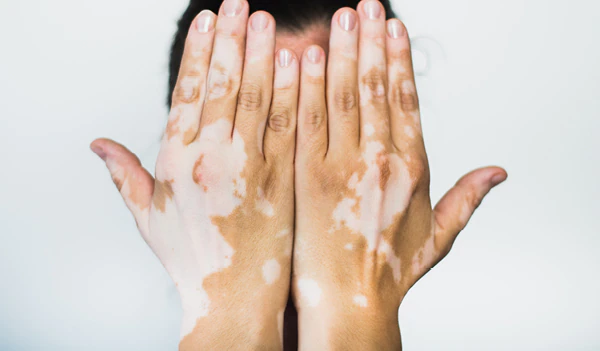Quick Inquiry


We understand the unique challenges of living with vitiligo and are committed to provide the best vitiligo treatment in Delhi. Our skin specialists use advanced techniques and personalized care to help manage and improve skin tone and texture.

Vitiligo is a long-lasting auto-immune disorder that causes patches of skin to lose pigment or colour. This happens when melanocytes – skin cells that make pigment – are attacked and destroyed, causing the skin to turn a milky-white colour. It is basically a skin disorder in which the skin tends to lose its colour, resulting in white or light coloured patches. The severity of vitiligo depends from person to person- while one person may have widespread patches, others may have only a few.
Some people have an increased risk of getting non-segmental vitiligo. Common factors of increased risk include:
Here are the causes of vitiligo in bullet points:
Autoimmune condition: The immune system mistakenly attacks and destroys melanocytes.
Genetic Factors: A family history of vitiligo or other autoimmune diseases may increase the risk.
Environmental Triggers: Exposure to certain chemicals, sunburn, or skin trauma can contribute to the onset of vitiligo.
Hormonal Changes: Hormonal fluctuations, particularly during pregnancy or puberty, may trigger the condition.
Stress: Emotional or physical stress can act as a trigger for vitiligo in some individuals.
Nutritional Deficiencies: Lack of certain vitamins and minerals, such as vitamin B12, folate, and zinc, may play a role.
Vitiligo can lead to anxiety, lack of confidence and self-consciousness. Many patients may resort to remedies for vitiligo treatment at home, but they can only worsen the symptoms.
At DermaSure, we diagnose vitiligo by reviewing your medical history and examining your skin. Depending on the severity of the case, we focus on two aspects prior to the treatment:
Stop the patches and spots from getting bigger and new spots from appearing.
Restore lost skin colour.
Vitiligo treatment for every patient may vary. Before creating a treatment plan, we prioritise a patient’s comfort. We take into account certain factors like your age, overall health, and the effects the disease has on your life.
The types of vitiligo, where it appears on the body, and how it’s progressing also play important roles. Here are the treatments considered for the patients who have vitiligo:
This works best on people who have recently developed vitiligo. When used short-term, this medication is often effective for both children and adults.
One advantage of this medication is that it can be used for a longer time than corticosteroids. These work best to treat the skin on the head or neck.
This medication aids in re-pigmentation. Dermatologists prescribe calcipotriene for children and adults.
In this, a dermatologist exposes your skin to (UV) light that is helpful in restoring your natural skin colour. If a significant area of your body needs treatment, your dermatologist may also prescribe phototherapy.
If other treatments fail to restore skin colour, surgery may be an option worth considering. The types of surgery used to treat vitiligo are cell transplant or skin graft.
Certain vitamins, minerals, amino acids, or enzymes can restore your natural skin colour.
It removes the remaining natural colour, creating an even skin tone. To remove the remaining colour from their skin, a patient applies cream to the areas of skin that still have pigment. The cream gradually removes the remaining colour.
If you are suffering from this disease, getting vitiligo treatment in Delhi from a best certified dermatologist can help. Dermasure can help you with this, and may also monitor other illnesses and refer you to other doctors, if necessary. We will provide you with all the benefits which can add to a more successful and steady treatment for the people with vitiligo.
Proper aftercare is essential for the best results after your vitiligo treatment. At Derma Sure, we provide detailed guidance on post-treatment care:
Sun Protection: Use a high-SPF sunscreen to protect treated areas from UV rays, as new pigment can be sensitive to the sun.
Moisturization: Keeping your skin hydrated helps in the healing process and prevents dryness.
Follow-Up Appointments: Regular follow-up appointments are crucial to monitor progress and make adjustments to the treatment plan if necessary. Our dermatologists will ensure you understand the steps needed to maximize your treatment results and keep your skin healthy.
The procedure may cause some discomfort, but it is usually brief and tolerable. Topical anaesthetic creams or ice packs can be used to minimise any potential discomfort.
Currently, there is no proven way of preventing vitiligo. There are many other skin disorders that can lead to skin lightening, which are treatable. If you have vitiligo, the sooner you start the vitiligo treatment, the better. If left untreated for years, vitiligo may be difficult to treat.
It depends on the case. If depigmentation treatment is used, it can take one to four years to get an even skin tone. When started early, the skin’s original colour may be restored in a matter of months.
Undergoing vitiligo treatment is better than doing home remedies or allowing the vitiligo to fester. With effective treatment, the spread of patches or spots can be controlled, and a dermatologist can work towards restoring the original skin tone.
Larger patches can occasionally keep growing and spreading, although they typically remain in one location for many years. Because some parts of skin lose and regain pigment throughout time, the location of smaller molecules varies. The affected skin differs depending on the individual receiving the vitiligo diagnosis.
Leave Them To #1 Skin & Hair Specialist In Delhi